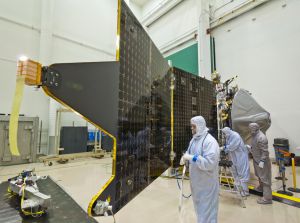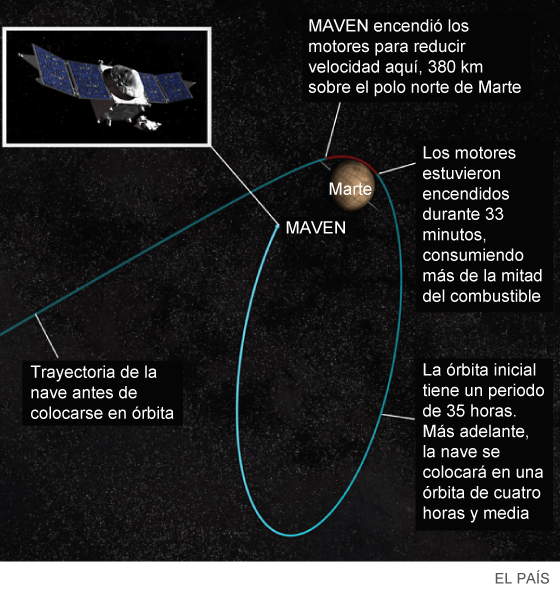
Illustration probe orbiting Mars `Maven’ NASA.
/ NASA / Goddard Space Flight Center
After ten months of travel, which has traveled 711 million kilometers, the spacecraft Maven , NASA placed into Mars orbit on Monday morning (Sunday 21 EE UU), just as planned. “NASA has a long history of scientific discoveries on Mars and the safe arrival of the Maven opens another chapter,” John Grunsfeld, astronaut and head of the directorate of science space agency said . “The Maven complement other robotic explorers on Mars, NASA and our partners to answer some of the fundamental questions that planet and life beyond Earth.”
In orbit of Mars are currently running the Mars Reconnaissance Orbiter (MRO), the Mars Odyssey , both NASA and the Mars Express , of the European Space Agency (ESA. Moreover, for the next 24 days is due to arrive (also in entering orbit there) of Mars Orbiter Mission (MOM), the first interplanetary probe india on Mars
.

Mounting the probe `Maven’ at Lockheed Martin facilities before its launch on 18 November 2013.
/ Lockheed Martin.
“What we do is research the top of the atmosphere [ Mars] as a way to understand how the loss of gas into space may have triggered the mechanisms of climate change, “he said a few days before the arrival of the Maven to Mars principal investigator mission, Bruce Jakosky, University of Colorado at Boulder. “We should get enough measurements to tell us what happened to the water, what happened to the carbon dioxide.” The atmosphere of Mars must be relatively dense in the past, but is now very thin, about 1% of Earth’s atmosphere at sea level.
“As a first probe to orbit devoted specifically to study the upper atmosphere of Mars, the Maven significantly increase our understanding of atmospheric story there, how climate has changed over time and how it has influenced the evolution of the surface and the potential habitability the planet, “said Charles Bolden, head of NASA. “It will also give information for a future manned mission to Mars in the thirties.”
The probe also made special observations advantage, on 19 October, over Comet Siding Spring about 132,000 miles from the red planet, just over a third of the distance from the Earth to the Moon. The Maven , with its ultraviolet spectrograph, take data from the Martian atmosphere a few days before and a few days after the passage of the comet to see if any effect is produced by the bombardment of dust, reports Nature .
Maven on Monday fired its engines for 33 minutes to draw closer to Mars to slow down and be trapped by the gravity of the neighboring planet. From now phase begins six weeks of checking all your equipment and, above all, the three packages of scientific instruments. Then will begin the research phase itself an Earth year long (although the probe carries enough fuel to work longer, provided the NASA approve and fund the extension). In its working orbit will approach 150 miles of the planet’s surface and away up to 6,200 kilometers, to obtain an overall view of the atmosphere in the data collection. He also made several dives to 125 kilometers to obtain a profile of the upper atmosphere and determine where it meets the floor. The cost of the mission amounts to 518 million euros.
In addition to his Martian studies, the new American probe orbiting Mars can serve as backup repeater for communications with Earth of the two wheeled vehicles NASA are working on the floor of the neighboring world: Curiosity and Opportunity

No comments:
Post a Comment